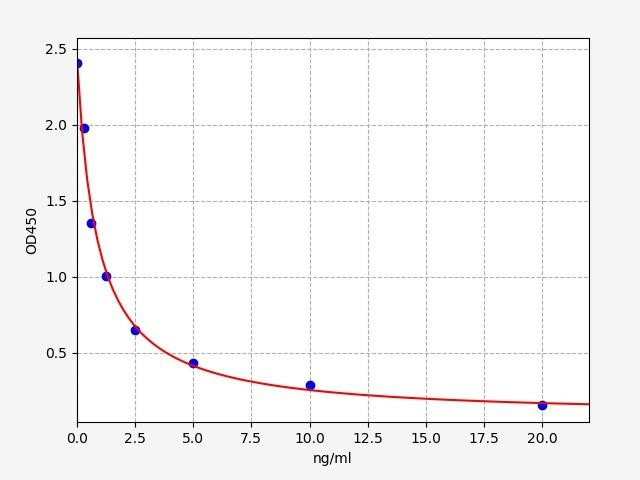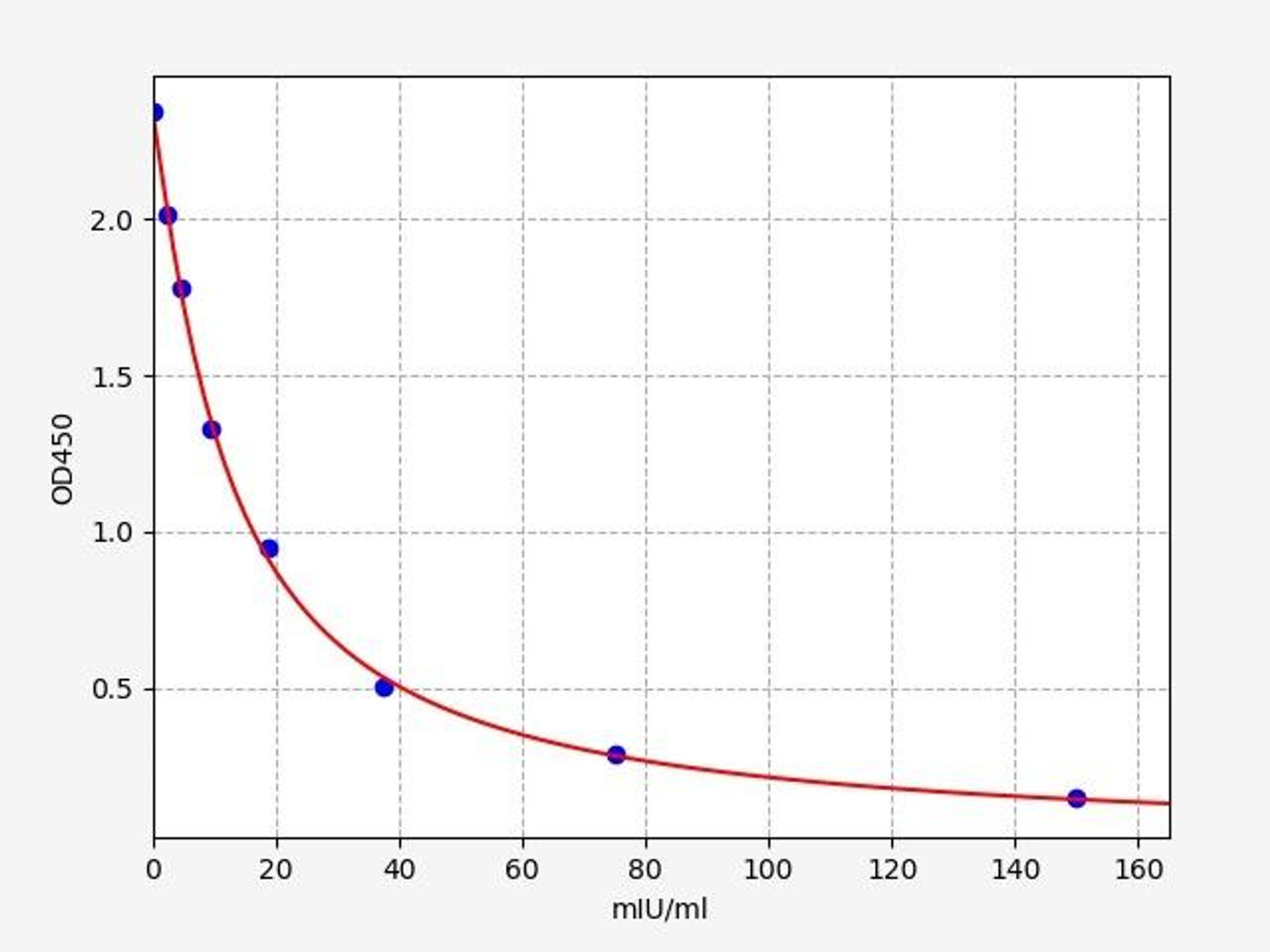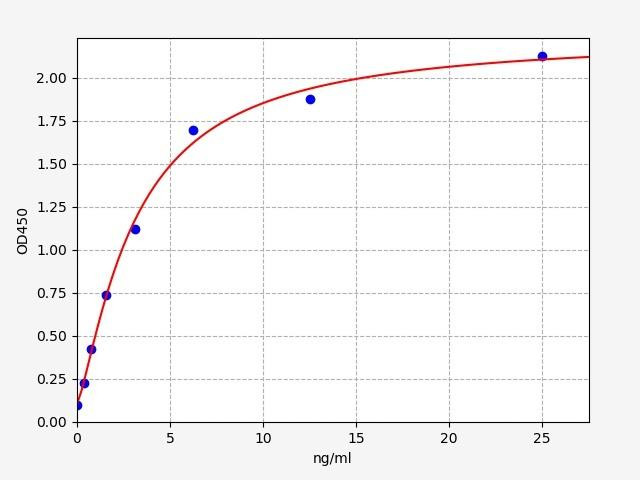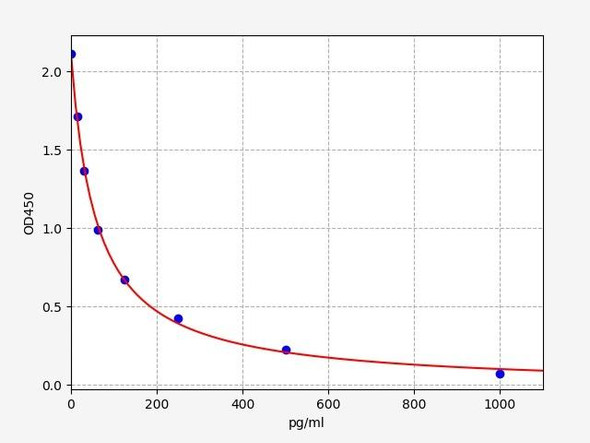Description
Mouse Estrogen ELISA Kit
Estrogen is a hormone that plays a crucial role in the development and functioning of the female reproductive system. Estrogen is responsible for regulating the menstrual cycle, promoting the development of secondary sexual characteristics in females, and supporting pregnancy. The Assay Genie Mouse Estrogen ELISA Kit is specifically designed for the quantitative measurement of estrogen levels in mouse biological samples, such as serum, plasma, and tissue homogenates and serves as a valuable tool for studying the role of estrogen in various research areas, including reproductive biology, endocrinology, cancer research, and hormonal regulation.
Key Features
| Save Time | Pre-coated 96 well plate | |
| Quick Start | Kit includes all necessary reagents | |
| Publication Ready | Reproducible and reliable results |
Overview
| Product Name: | Mouse Estrogen ELISA Kit (MOFI01442) |
| Product Code: | MOFI01442 |
| Size: | 96 Assays |
| Alias: | Estrogen ELISA Kit |
| Detection Method: | Competitive ELISA |
| Application: | This immunoassay kit allows for the in vitro quantitative determination of Mouse Estrogen concentrations in serum plasma and other biological fluids. |
| Sensitivity: | < 9.375pg/ml |
| Range: | 15.625-1000pg/ml |
| Storage: | 4°C for 6 months |
| Note: | For Research Use Only |
Additional Information
| Recovery | Matrices listed below were spiked with certain level of Mouse Estrogen and the recovery rates were calculated by comparing the measured value to the expected amount of Mouse Estrogen in samples. (Not Available.) |
| Linearity: | The linearity of the kit was assayed by testing samples spiked with appropriate concentration of Mouse Estrogen and their serial dilutions. The results were demonstrated by the percentage of calculated concentration to the expected. (Not Available) |
| Intra Assay | CV < 8% |
| Inter Assay | CV < 10% |
Kit Components
| Component | Quantity | Storage |
| ELISA Microplate (Dismountable) | 8x12 strips | 4°C for 6 months |
| Lyophilized Standard | 2 | 4°C/ -20°C |
| Sample/Standard Dlution Buffer | 20ml | 4°C |
| Biotin-labeled Antibody (Concentrated) | 120ul | 4°C (Protection from light) |
| Antibody Dilution Buffer | 10ml | 4°C |
| HRP-Streptavidin Conjugate (SABC) | 120ul | 4°C (Protect from light) |
| SABC Dilution Buffer | 10ml | 4°C |
| TMB Substrate | 10ml | 4°C (Protection from light) |
| Stop Solution | 10ml | 4°C |
| Wash Buffer (25X) | 30ml | 4°C |
| Plate Sealer | 5 | - |
Other materials required:
- Microplate reader with 450 nm wavelength filter
- Multichannel Pipette, Pipette, microcentrifuge tubes and disposable pipette tips
- Incubator
- Deionized or distilled water
- Absorbent paper
- Buffer resevoir
Protocol
*Note: Protocols are specific to each batch/lot. For the correct instructions please follow the protocol included in your kit.
Equilibrate the TMB substrate for at least 30 min at 37°C beforeuse. When diluting samples and reagents, they must be mixed completely andevenly. It is recommended to plot a standard curve for each test.
| Step | Procedure |
| 1. | Set standard, test sample and control (zero) wells on the pre-coatedplate respectively, and then, record their positions. It isrecommended to measure each standard and sample in duplicate. Washplate 2 times before adding standard, sample and control (zero) wells! |
| 2. | Add Sample and Biotin-detection antibody: Add 50µL of Standard, Blank or Sample per well. The blankwell is added with Sample Dilution Buffer. Immediately add 50 µL of biotin-labelled antibody workingsolution to each well. Cover with the plate sealer provided. Gently tap the plate to ensure thoroughmixing. Incubate for 45 minutes at 37°C. (Solutions are added to the bottom of micro-ELISA platewell, avoid touching plate walls and foaming). |
| 3. | Wash: Aspirate each well and wash, repeating the process three timesWash by filling each well with Wash Buffer (approximately 350µL)using a squirt bottle, multi-channel pipette, manifold dispenser orautomated washer. Complete removal of liquid at each step is essentialto good performance. After the last wash, remove any remaining WashBuffer by aspirating or decanting. Invert the plate and pat it againstthick clean absorbent paper. |
| 4. | HRP-Streptavidin Conjugate(SABC): Add 100µL of SABC workingsolution to each well. Cover with a new Plate sealer. Incubate for30minutes at 37°C. |
| 5. | Wash: Repeat the aspiration/wash process for five times. |
| 6. | TMB Substrate: Add 90µL of TMB Substrate to each well. Coverwith a new Plate sealer. Incubate for about 10-20 minutes at 37°C.Protect from light. The reaction time can be shortened or extendedaccording to the actual color change, but not more than 30minutes.When apparent gradient appeared in standard wells, you can terminatethe reaction. |
| 7. | Stop: Add 50µL of Stop Solution to each well. Color turn toyellow immediately. The adding order of stop solution should be as thesame as the substrate solution. |
| 8. | OD Measurement: Determine the optical density (OD Value) of each wellat once, using a microplate reader set to 450 nm. You should open themicroplate reader ahead, preheat the instrument, and set the testing parameters. |
Sample Preparation
When carrying out an ELISA assay it is important to prepare your samples in order to achieve the best possible results. Below we have a list of procedures for the preparation of samples for different sample types.
| Sample Type | Protocol |
| Serum | If using serum separator tubes, allow samples to clot for 30 minutes at room temperature. Centrifuge for 10 minutes at 1,000x g. Collect the serum fraction and assay promptly or aliquot and store the samples at -80°C. Avoid multiple freeze-thaw cycles. If serum separator tubes are not being used, allow samples to clot overnight at 2-8°C. Centrifuge for 10 minutes at 1,000x g. Remove serum and assay promptly or aliquot and store the samples at -80°C. Avoid multiple freeze-thaw cycles. |
| Plasma | Collect plasma using EDTA or heparin as an anticoagulant. Centrifuge samples at 4°C for 15 mins at 1000 × g within 30 mins of collection. Collect the plasma fraction and assay promptly or aliquot and store the samples at -80°C. Avoid multiple freeze-thaw cycles. Note: Over haemolysed samples are not suitable for use with this kit. |
| Urine & Cerebrospinal Fluid | Collect the urine (mid-stream) in a sterile container, centrifuge for 20 mins at 2000-3000 rpm. Remove supernatant and assay immediately. If any precipitation is detected, repeat the centrifugation step. A similar protocol can be used for cerebrospinal fluid. |
| Cell culture supernatant | Collect the cell culture media by pipette, followed by centrifugation at 4°C for 20 mins at 1500 rpm. Collect the clear supernatant and assay immediately. |
| Cell lysates | Solubilize cells in lysis buffer and allow to sit on ice for 30 minutes. Centrifuge tubes at 14,000 x g for 5 minutes to remove insoluble material. Aliquot the supernatant into a new tube and discard the remaining whole cell extract. Quantify total protein concentration using a total protein assay. Assay immediately or aliquot and store at ≤ -20 °C. |
| Tissue homogenates | The preparation of tissue homogenates will vary depending upon tissue type. Rinse tissue with 1X PBS to remove excess blood & homogenize in 20ml of 1X PBS (including protease inhibitors) and store overnight at ≤ -20°C. Two freeze-thaw cycles are required to break the cell membranes. To further disrupt the cell membranes you can sonicate the samples. Centrifuge homogenates for 5 mins at 5000xg. Remove the supernatant and assay immediately or aliquot and store at -20°C or -80°C. |
| Tissue lysates | Rinse tissue with PBS, cut into 1-2 mm pieces, and homogenize with a tissue homogenizer in PBS. Add an equal volume of RIPA buffer containing protease inhibitors and lyse tissues at room temperature for 30 minutes with gentle agitation. Centrifuge to remove debris. Quantify total protein concentration using a total protein assay. Assay immediately or aliquot and store at ≤ -20 °C |
| Breast Milk | Collect milk samples and centrifuge at 10,000 x g for 60 min at 4°C. Aliquot the supernatant and assay. For long term use, store samples at -80°C. Minimize freeze/thaw cycles. |
Estrogen Background
What is Estrogen ?
Estrogen is a hormone that plays a crucial role in the development and functioning of the female reproductive system. It is primarily produced in the ovaries, although small amounts are also produced by the adrenal glands and fat cells. Estrogen is responsible for regulating the menstrual cycle, promoting the development of secondary sexual characteristics in females, and supporting pregnancy.
Estrogen Structure
Estrogen is a steroid hormone belonging to the class of compounds known as estradiols. The three main naturally occurring forms of estrogen are estradiol, estrone, and estriol. Estradiol is the most potent and prevalent form, especially during the reproductive years. The chemical structure of estrogen consists of four interconnected rings with a hydroxyl (-OH) group attached to one of the rings.
Estradiol's molecular formula is C18H24O2
Estrogen Function
The primary function of estrogen is to regulate the growth, development, and maintenance of female reproductive tissues and organs. It stimulates the growth of the uterine lining (endometrium) during the menstrual cycle and is essential for the preparation of the uterus for implantation of a fertilized egg. Estrogen also promotes the development of breast tissue and influences the distribution of body fat in a female pattern.
In addition to its reproductive functions, estrogen affects various other systems in the body. It helps maintain healthy bones by inhibiting bone breakdown and promoting bone formation. Estrogen also influences cholesterol levels by increasing high-density lipoprotein (HDL) cholesterol and decreasing low-density lipoprotein (LDL) cholesterol. It plays a role in maintaining the health of the cardiovascular system and has effects on the central nervous system, including mood regulation and cognitive function.
Estrogen Synthesis and Processing
The primary site of estrogen synthesis is the ovaries in premenopausal women, while in postmenopausal women, the production mainly occurs in peripheral tissues, such as adipose tissue and the adrenal glands. The process begins with the synthesis of androgens, such as testosterone, either in the ovaries or the adrenal glands. These androgens are then converted into estrogens through the action of the enzyme aromatase. Aromatase is present in various tissues, including the ovaries, adipose tissue, and placenta. Once estrogens are synthesized, they enter the bloodstream and are transported to target tissues, where they bind to estrogen receptors, initiating the physiological effects of estrogen. The liver plays a crucial role in the metabolism and processing of estrogen by conjugating them with sulfate or glucuronide groups, facilitating their excretion from the body via the bile or urine. The synthesis and processing of estrogen are tightly regulated processes that contribute to the maintenance of hormonal balance and overall physiological function.
Estrogen Receptors
Estrogen receptors (ERs) are proteins located within cells that are responsible for mediating the effects of estrogen. There are two main types of estrogen receptors: estrogen receptor alpha (ERα) and estrogen receptor beta (ERβ). These receptors are present in various tissues throughout the body, including the reproductive organs, breast tissue, bone, brain, and cardiovascular system.
When estrogen enters the bloodstream, it binds to estrogen receptors, triggering a cascade of cellular events known as estrogen signaling pathways. The binding of estrogen to the receptor leads to a conformational change in the receptor, allowing it to interact with specific regions of DNA known as estrogen response elements (EREs). This interaction between the estrogen receptor and EREs results in the activation or repression of target genes.
Estrogen Signalling Pathways
Estrogen signaling pathways can be categorized into genomic and non-genomic pathways:
1. Genomic Pathway: In this pathway, estrogen receptors act as transcription factors, meaning they regulate gene expression. After estrogen binds to the receptor, the receptor complex moves into the nucleus and binds to specific DNA sequences within target genes. This binding activates the transcription process, resulting in the synthesis of messenger RNA (mRNA) molecules. These mRNA molecules are then translated into proteins that mediate the biological effects of estrogen.
2. Non-genomic Pathway: The non-genomic pathway involves rapid, non-transcriptional effects of estrogen. In this pathway, estrogen receptors are localized on the cell membrane or within the cytoplasm. When estrogen binds to these receptors, it triggers the activation of signaling cascades, such as protein kinase pathways. These pathways can lead to the rapid modulation of various cellular processes, including ion channel activity, calcium mobilization, and kinase activation. The non-genomic pathway allows estrogen to elicit rapid physiological responses even before changes in gene expression occur.
Estrogen Blockers
Estrogen blockers, also known as selective estrogen receptor modulators (SERMs), are pharmaceutical agents that interfere with estrogen receptor activity. They work by competitively binding to estrogen receptors, preventing estrogen from binding and exerting its effects. This inhibition is used in the treatment of estrogen-driven conditions, such as hormone-sensitive breast cancer. Estrogen blockers, such as tamoxifen and raloxifene, have shown efficacy in reducing the risk of breast cancer recurrence and preventing the development of breast cancer in high-risk individuals.
Estrogen Supplements (Hormone Replacement Therapy)
Estrogen supplements, also referred to as hormone replacement therapy (HRT), are prescribed to address hormonal imbalances, particularly in menopausal women. Estrogen supplementation aims to alleviate menopausal symptoms, such as hot flashes, vaginal dryness, and mood changes. Additionally, it helps prevent postmenopausal osteoporosis by maintaining bone health. The administration of estrogen supplements, whether through oral pills, transdermal patches, or other forms, should be individualized and carefully monitored by healthcare professionals to ensure the appropriate dosage and duration, taking into consideration the potential risks and benefits for each patient.
Mouse Estrogen ELISA Kit FAQs
Q: What is the purpose of the Mouse Estrogen ELISA Kit?
The Assay Genie Mouse Estrogen ELISA Kit is specifically designed for the quantitative measurement of estrogen levels in mouse biological samples, such as serum, plasma, and tissue homogenates and serves as a valuable tool for studying the role of estrogen in various research areas, including reproductive biology, endocrinology, cancer research, and hormonal regulation.
Q: What types of samples can be used with the Mouse Estrogen ELISA Kit?
he Mouse Estrogen ELISA Kit is compatible with various mouse biological samples, including serum, plasma, and tissue homogenates. It is important to follow the recommended sample preparation protocols provided with the kit to ensure accurate and reliable results.
Q: Can this kit measure estrogen levels in other species besides mice?
No, this ELISA kit is specifically designed and validated for the measurement of estrogen levels in mouse samples. It may not provide accurate results when used with samples from other species. For measuring estrogen levels in different species, specific ELISA kits validated for those species should be used.
Q: Where can I find additional technical support or assistance with the Mouse Estrogen ELISA Kit?
For any technical inquiries or assistance regarding the Mouse Estrogen ELISA Kit, you can reach out to our team. They will be available to answer your questions and provide the necessary guidance to ensure a successful experiment.
Related Products

| Mouse Progesterone ELISA Kit | |
|---|---|
| ELISA TYPE: | Competitive ELISA, Coated with Antigen |
| SENSITIVITY: | 0.188ng/ml |
| RANGE: | 0.313-20ng/ml |

| Mouse FSH ELISA Kit | |
|---|---|
| ELISA TYPE: | Competitive ELISA, Coated with Antigen |
| SENSITIVITY: | 1.406mIU/ml |
| RANGE: | 2.344-150mIU/ml |

| Mouse Osteocalcin ELISA Kit | |
|---|---|
| ELISA TYPE: | Sandwich ELISA, Double Antibody |
| SENSITIVITY: | 0.234ng/ml |
| RANGE: | 0.391-25ng/ml |









